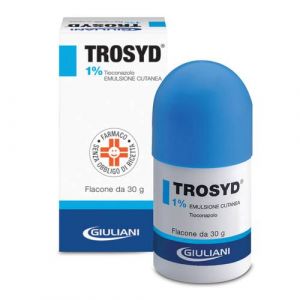NAME
TROSYD
PHARMACOTHERAPEUTIC CATEGORY
Topical antifungals.
ACTIVE PRINCIPLES
Tioconazole.
EXCIPIENTS
Cream 1%: polysorbate 60, sorbitan monostearate, cetostearyl alcohol, 2-octyldodecanol, cetyl ester wax, benzyl alcohol, purified water. Skin powder 1%: talc, magnesium myristate, kaolin, precipitated silica. Skin emulsion 1%: emulsifying wax, cetyl alcohol, cetylstearyl alcohol, coconut oil, glycerylstearate and palmitate, propylene glycol, benzyl alcohol, purified water. Skin solution for nail use 28%: undecylenic acid, ethyl acetate. 1% cutaneous solution: monoethanolamine laurilsulfate, lecithinamide, polyglycollum, undebenzophen, lactic acid, soothing lipoessential, purified water.
INDICATIONS
Cream 1% - Skin powder 1% - Skin emulsion 1%: dermatomycosis sustained by dermatophytes, yeasts and other fungi sensitive to Tioconazole; skin infections with drug-sensitive Gram-positive bacteria; due to the concomitant antifungal and antibacterial activity, it is particularly indicated in mixed skin infections. Skin solution for nail use 28%: onychomycosis caused by dermatophytes and yeasts; due to its concomitant antibacterial activity, it is particularly indicated in mixed infections. 1% cutaneous solution: indicated in the topical treatment of skin infections caused by fungi (dermatophytes and yeasts), even if associated with superinfections by Gram-positive bacteria sensitive to it, as an adjunct to therapy with other specific topical preparations. The skin solution allows greater ease of application in more extensive dermatomycoses and performs a medicated cleansing of hairless or hairy skin. Furthermore, allowing the treatment of a large skin surface, it makes it possible to eliminate the pathogen not only where skin morphological changes are detectable but also where the skin is apparently healthy.
CONTRAINDICATIONS / SECONDARY EFFECT
Hypersensitivity to the active substance or to any of the excipients; pregnancy.
DOSAGE
Cream 1% - Powder 1% - Skin emulsion 1%: the medicine should be applied with a light massage twice a day, morning and evening, on the affected skin and the one immediately surrounding it. In the intertrigo areas the cream should be applied in small quantities and well spread, to avoid maceration phenomena. The skin powder is available in a container with which it can be directly applied in a uniform layer. The skin emulsion is applied with the fingertips and with a cotton swab. The duration of treatment required to achieve healing varies from patient to patient and in relation to the infecting agent and site of infection. A 7-day treatment is usually sufficient to achieve healing in most patients with Pityriasis versicolor, while up to 6 weeks of treatment may be required in case of severe forms of Tinea pedis (athlete's foot), especially with regard to chronic hyperkeratotic clinical disease. The duration of treatment required for dermatophytic infections at other locations for Candidiasis and Erythrasma is usually between 2 and 4 weeks. 28% cutaneous solution for nail use: apply the drug on the infected nail and in the periungual region twice a day, morning and evening, using the special brush. The solvent contained in the drug dries in 5 minutes leaving a thin transparent and oily film. Even if this film is randomly removed it does not decrease the drug's activity, and therefore it is not necessary to apply it again. It is recommended not to use an occlusive dressing. The duration of the treatment required to achieve healing varies from patient to patient, and is related to the infecting agent and the extent of the lesion. Generally the therapy can last up to 6 months on average, but it can be prolonged up to a year. 1% skin solution: in contact with the skin it forms a foamy solution: use the amount of solution necessary in relation to the skin surface to be treated, using the product as a liquid detergent, once a day, and rinse with water a few minutes after application. The use of the cutaneous solution must be carried out together with concomitant topical specific antifungal treatment, applied after the use of the solution. The duration of treatment required to achieve healing varies according to the infecting agent and the site of infection and is usually between two and four weeks. According to a medical opinion, treatment with the cutaneous solution can be continued even after the end of other specific topical therapies in order to reduce the risk of relapses.
STORAGE
No particular precautions for storage.
WARNINGS
The application of products for topical use, especially if prolonged, can give rise to sensitization phenomena.
INTERACTIONS
No interactions or incompatibilities with other medicaments are known so far.
SIDE EFFECTS
In very rare cases a slight and transient local irritation has been observed. However, in the presence of hypersensitivity reactions, it will be necessary to interrupt the treatment and institute an appropriate therapy.
PREGNANCY AND BREASTFEEDING
There are no adequate and well-controlled studies on the use of the medicinal product in pregnancy or breastfeeding. Therefore, the medicine should be used only in case of need ', after evaluating the expected benefit to the mother in relation to the possible risk to the fetus or infant. Cutaneous solution for nail use: although the systemic absorption after topical administration is negligible, however, since the treatment of onychomycosis can last for many months, the use of the cutaneous solution for nail use in pregnancy is contraindicated.
